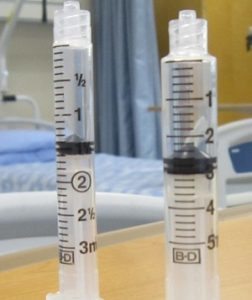Chapter 7: Parenteral Medication Administration
7.5 Intramuscular Injections
Critical Thinking Exercises: Questions, Answers, and Sources / References
- When giving an IM injection, how can you avoid injury to a patient who is very thin?
Answer: the nurse should consider the following to prevent physical injury to the patient-
- When choosing a needle size, factors to be considered include the weight of the patient, age, amount of adipose tissue, medication viscosity, and injection site
- Because of the adverse and documented effects of pain associated with IM injections, nurses are encouraged to consider other routes first and use the IM route of administration as a last alternative
- The ventrogluteal site is free from blood vessels and nerves, and it has the greatest thickness of muscle when compared to other sites
- The needle length is based on patient weight and body mass index. A thin adult may require a 16 mm to 25 mm (5/8 to 1 in) needle
- Older adults and thin patients may only tolerate up to 1 ml in a single injection.
Sources:
Cocoman, A., & Murray, J. (2008). Intramuscular injections: A review of best practice for mental health nurses. Journal of Psychiatry Mental Health Nursing, 15(5), 424-434. doi: 10.1111/j.1365-2850.2007.01236.
Hunter, J. (2008). Intramuscular injection techniques. Nursing Standard, 22(24), 35-40.
Malkin, B. (2008). Are techniques used for intramuscular injection based on research evidence? Nursing Times, 104(50-51), 48–51.
Ogston-Tuck, S. (2014a). Intramuscular injection technique: An evidence-based approach. Nursing Standard, 29(4), 52-59. http://journals.rcni.com/doi/pdfplus/10.7748/ns.29.4.52.e9183.
Perry, A., Potter, P., & Ostendorf, W. (2017). Clinical skills and nursing techniques (9th ed.). St. Louis, MO: Elsevier-Mosby.
Workman, B. (1999). Safe injection techniques. Nursing Standard, 13(39), 47-53. https://doi.org/10.7748/ns1999.06.13.39.47.c2623.
2. Your client has two fractured femurs and a fractured right humerus. Discuss which site(s) are appropriate for IM injection. Discuss other options for pain control.
Answer: IM injection sites are not appropriate in a limb with a fracture. Generally because there is risk of injury with IM injections, in this situation it is important to avoid both legs including ventrogluteal sites and the deltoid site in the right arm. IM injections may be possible in the left deltoid. With repeated IM injections it is important to rotate sites in order to prevent injury at the site (hypertrophy) and with only one site to choose from, rotation is impossible. Strongly suggest asking for analgesics with non IM route ie. subcutaneous, oral, IV.
- Match the angle of injection with the correct route
| Angle of injection: | Answer: Parenteral route: |
| 90 degrees | IM, SC if there is a lot of adipose tissue |
| 45 degrees | SC |
| 10-15 degrees | intradermal |
Source: Perry, A., Potter, P., & Ostendorf, W. (2017). Clinical skills and nursing techniques (9th ed.). St. Louis, MO: Elsevier-Mosby.
2. With the following image(s) read the syringe to determine the correct volume.

Answer: 1.4 ml (left syringe) 2.6 ml (right syringe)
Attribution: Reading syringes by R. Anderson is used under a Creative Commons Attribution-Share Alike 4.0 International license.
3. Identify rational for choice of an IM injection site. Answer:
| Site | Rationale |
| Deltoid | Easily accessible. Potential for injury because nerves and artery lie witin the upper arm along the humerus. Use this site for small volumes (ie. 1-2 ml) |
| Ventro Gluteal | On a normal sized adult can tolerate the largest volume of medication (ie. 3ml)
Is deep and away from major nerves and blood vessels Well developed in adults and young children |
| Vastus lateralis | On a normal sized adult can tolerate up to 3ml / injection |
Source: Perry, A., Potter, P., & Ostendorf, W. (2017). Clinical skills and nursing techniques (9th ed.). St. Louis, MO: Elsevier-Mosby.
4. A patient requires dimenhydrinate 25 mg IM. The ampule is 50 mg / ml. What volume should be administered?
-
- 25mg
- 25ml
- 0.5mg
- 0.5ml
Answer: D. 25mg/50mg x 1 ml = 0.5ml
5. The patient is an 18 year old 75 kg male.What site is appropriate for this injection? (select all that apply)
| IM injection site | Answer | |
| a. | deltoid | Correct. A 0.5ml volume can be safely administered IM into these sites. |
| b. | ventrogluteal | Correct. A 0.5ml volume can be safely administered IM into these sites. |
| c. | vastus lateralis | Correct. A 0.5ml volume can be safely administered IM into these sites. |
| d. | dorso gluteal | Incorrect. Dorso gluteal should never be used due to risk of injury to nerves & blood vessels. |
Source: Perry, A., Potter, P., & Ostendorf, W. (2017). Clinical skills and nursing techniques (9th ed.). St. Louis, MO: Elsevier-Mosby.
6. Match the following landmarks with the correct IM injection site:
| IM injection site | Answer |
| Deltoid
|
Acromium process, axilla crease |
| Ventrogluteal
|
Anterior superior iliac crest, greater trochanter |
| Vastus lateralis
|
Greater trochanter, knee, middle third of muscle |
Source: Perry, A., Potter, P., & Ostendorf, W. (2017). Clinical skills and nursing techniques (9th ed.). St. Louis, MO: Elsevier-Mosby.
7. Which of the following correctly describes the purpose of Z tracking for IM injections is:
a. It promotes quicker absorption of the medication
b. It prevents medication from leaking out and causing discomfort at the site
c. It provides a distraction for the patient during the injection
d. It makes the skin more elastic and easier to penetrate with the needle
Answer: B
Source: Perry, A., Potter, P., & Ostendorf, W. (2017). Clinical skills and nursing techniques (9th ed.). St. Louis, MO: Elsevier-Mosby.
Media Attributions
- Reading Syringes © Renée Anderson is licensed under a Public Domain license

